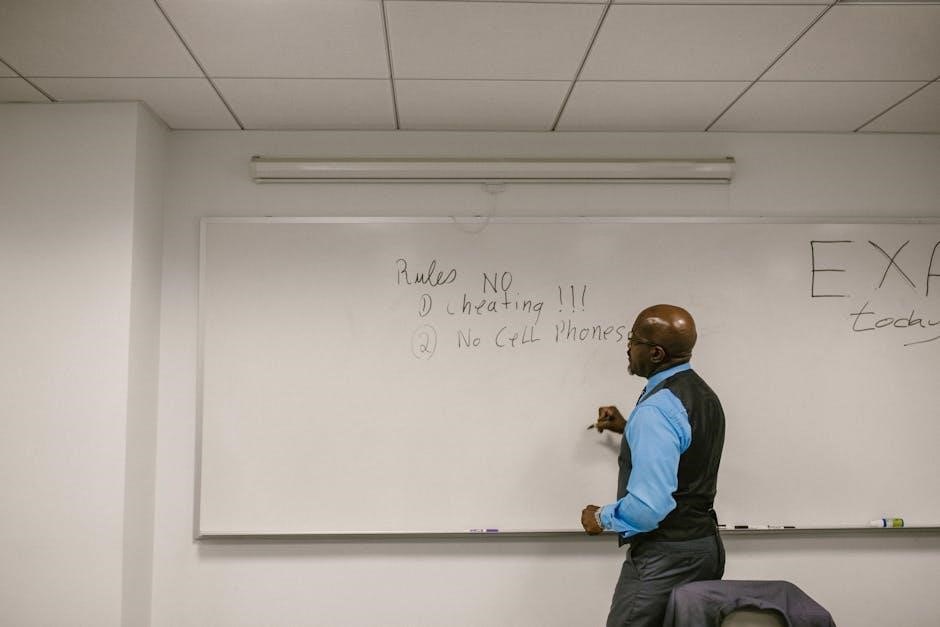Overview of IRS Form 990 Schedule B
IRS Form 990 Schedule B is a supplementary form required for tax-exempt organizations to report detailed information about contributions received during the tax year, ensuring transparency and compliance with IRS regulations.
1.1. What is Schedule B?

Schedule B is a supplementary form required by the IRS for tax-exempt organizations to report detailed information about contributions received during the tax year. It accompanies Form 990, 990-EZ, or 990-PF and is used to disclose contributions of $5,000 or more from individual contributors. The schedule provides transparency by outlining the sources of an organization’s funding, ensuring compliance with IRS regulations. It includes details such as the contributor’s name, address, and the type and amount of contributions, whether cash or noncash. Schedule B is essential for organizations to maintain their tax-exempt status and demonstrate accountability to the public and the IRS. By reporting contributions accurately, nonprofits uphold their commitment to transparency and adhere to federal filing requirements.
1.2. Importance of Schedule B
Schedule B plays a critical role in ensuring transparency and accountability for tax-exempt organizations. By detailing significant contributions, it helps the IRS monitor compliance with tax-exempt status requirements and prevents misuse of funds. Public disclosure of Schedule B promotes trust in nonprofits by revealing their financial sources. It also aids the IRS in identifying potential fraud or misuse of charitable contributions. Additionally, Schedule B ensures organizations maintain accurate records of their funding, which is essential for audit purposes. Compliance with Schedule B requirements demonstrates an organization’s commitment to ethical practices and financial integrity. Ultimately, it supports the IRS’s mission to oversee tax-exempt entities while fostering public confidence in the nonprofit sector.

Who is Required to File Schedule B?
Organizations filing Form 990, 990-EZ, or 990-PF must file Schedule B if they receive contributions of $5,000 or more from any one contributor during the tax year.

2.1. General Rule
The general rule requires organizations filing Form 990, 990-EZ, or 990-PF to complete Parts I and II of Schedule B if they receive contributions totaling $5,000 or more from any single contributor during the tax year. This applies to both cash and noncash contributions, ensuring transparency and accountability; The IRS mandates this to monitor significant donors and prevent financial mismanagement. Organizations must accurately report each contributor’s details, including their name, address, and the type of contribution. This rule ensures that substantial donations are publicly disclosed, maintaining trust in tax-exempt entities. Compliance with this rule is essential to avoid penalties and maintain tax-exempt status. Additionally, organizations must verify contributors’ total contributions to determine if the $5,000 threshold is met. This rule is fundamental for upholding the integrity of nonprofit financial reporting.
2.2. Special Rules
Beyond the general rule, certain organizations must adhere to special rules when filing Schedule B. For instance, organizations meeting the 33% support test must report contributors giving $5,000 or 2% of total contributions, whichever is greater. Additionally, entities receiving over $1,000 for religious, charitable, scientific, literary, educational purposes, or to prevent cruelty to children or animals must complete Parts I and II of Schedule B. If contributions are under $1,000, only the amount needs to be reported. Furthermore, section 501(c)(3) organizations must report governmental units as contributors. These special rules ensure comprehensive reporting for specific types of donations and organizations, enhancing transparency and compliance with IRS requirements. Accurate adherence to these rules is crucial to maintain tax-exempt status and avoid penalties.

Key Components of Schedule B
Schedule B consists of three main parts: Part I details contributor information, Part II summarizes total contributions, and Part III addresses special rules, ensuring comprehensive reporting of donations and gifts.
3.1. Part I: Contributors
Part I of Schedule B requires detailed reporting of each contributor who provided contributions exceeding $5,000 or 2% of total revenues during the tax year. Organizations must list the name, address, and total contributions for each contributor. This section also categorizes contributions as cash, noncash, or payroll deductions, ensuring transparency. Noncash contributions, such as real estate or equipment, must include descriptions. Additionally, contributors include individuals, corporations, trusts, and other entities, with specific rules for governmental units. The IRS mandates this reporting to maintain accountability and public trust, aligning with the organization’s financial disclosures in Form 990. Accurate and complete reporting in Part I is crucial for compliance and avoiding penalties.
3.2. Part II: Summary of Contributions
Part II of Schedule B provides a summary of contributions reported in Part I, offering a concise overview of total contributions and specific categories. This section requires organizations to report the total contributions from all contributors, as well as breakdowns by type, such as cash, noncash, and payroll deductions. Additionally, Part II includes a section for contributions subject to special rules, such as those exceeding $1,000 for religious, charitable, scientific, or educational purposes. This summary ensures clarity and helps the IRS verify the accuracy of the detailed information provided in Part I. By categorizing contributions, Part II facilitates compliance with IRS requirements and maintains transparency in financial reporting. It is essential to ensure all figures align with those in Part I to avoid discrepancies and potential penalties.
3.3. Part III: Special Rules
Part III of Schedule B addresses special reporting requirements for certain types of contributions. Organizations must report contributions received for specific purposes, such as religious, charitable, scientific, or educational activities, if they exceed $1,000. This section applies to organizations classified under Section 501(c)(7), (8), or (10), which include social clubs, fraternal beneficiary societies, and domestic fraternal societies. For each contributor whose gifts total more than $1,000 during the tax year, the organization must provide the contributor’s name, address, and total contribution amount. Noncash contributions require additional details, such as a description of the property and its fair market value. This section ensures transparency for contributions earmarked for specific purposes, aligning with IRS requirements for clarity and accountability in financial reporting. Accurate completion of Part III is crucial for maintaining tax-exempt status and avoiding compliance issues.

Important Considerations When Filing Schedule B
- Ensure accuracy in reporting contributions, including noncash and anonymous donations.
- Provide detailed descriptions and fair market values for noncash contributions.
- Maintain transparency by clearly disclosing contributions and adhering to IRS guidelines.
4.1. Noncash Contributions
Noncash contributions, such as real estate, vehicles, artwork, or intellectual property, must be reported on Schedule B. Organizations must provide detailed descriptions and fair market values for these contributions. A qualified appraisal is often required for noncash contributions exceeding certain thresholds to determine their value accurately. Additionally, the type of contribution (e.g., “Noncash”) must be specified. Noncash contributions are subject to specific reporting rules to ensure transparency and compliance with IRS guidelines. Proper documentation and valuation are critical to avoid discrepancies and ensure accurate disclosure of noncash gifts. Failure to report noncash contributions correctly can lead to compliance issues, emphasizing the importance of careful recordkeeping and adherence to IRS instructions.
4.2. Anonymous Contributors
Anonymous contributors are those whose identities are not disclosed by the organization. For tax purposes, nonprofits must still report anonymous contributions on Schedule B but are not required to disclose the contributor’s name or address. However, the organization must indicate that the contribution is anonymous and provide the total amount received. Anonymous contributions are subject to the same reporting thresholds as other contributions, meaning they must meet the $5,000 or 2% threshold to be reported in Part I. The organization should maintain internal records to substantiate the contribution, even if the donor remains anonymous. Special rules may apply if the anonymous contribution is for religious, charitable, or other specific purposes, requiring additional disclosures in Part III. Proper handling of anonymous contributions ensures compliance with IRS transparency requirements while respecting donor confidentiality.

4.3. Religious or Charitable Contributions
Contributions made for religious, charitable, scientific, literary, educational purposes, or to prevent cruelty to children or animals are subject to specific reporting rules on Schedule B. Organizations under Section 501(c)(3) and other exempt entities must report contributions exceeding $1,000 for these purposes. For contributions below $1,000, only the total amount is reported without disclosing the contributor’s identity. Noncash contributions, such as real estate or artwork, require detailed explanations. Religious or charitable contributions must align with the organization’s tax-exempt mission and be reported consistently with financial statements and Form 990, Part VIII. Proper documentation ensures compliance with IRS requirements, maintaining transparency while fulfilling the organization’s charitable objectives.

Compliance Tips for Accurate Filing
Ensure accurate reporting by understanding filing requirements, maintaining detailed records, and adhering to IRS guidelines. Proper documentation and timely submissions are essential for compliance with Schedule B regulations.
5.1. Recordkeeping
Accurate and detailed recordkeeping is crucial for efficient preparation of Form 990 Schedule B. Tax-exempt organizations must maintain records of all contributions, including donor information, amounts, and types of contributions. This includes documenting noncash contributions, such as property or goods, with descriptions and valuations. Proper documentation ensures compliance with IRS regulations and facilitates accurate reporting. Additionally, organizations should retain records of contributor agreements, appraisals for noncash donations, and correspondence with donors. Implementing a systematic approach to recordkeeping helps streamline the filing process and minimizes errors. Regular reviews and updates to these records are essential to ensure completeness and accuracy, supporting the organization’s transparency and accountability to stakeholders and regulatory bodies.
5.2. Deadlines
The deadline for filing Form 990 Schedule B depends on the organization’s tax year and the form it is attached to. For most tax-exempt organizations, the standard deadline is May 15th of each year, covering the previous tax year. However, if the organization operates on a different fiscal year, the deadline corresponds to the 15th day of the 5th month following the end of its tax year. An automatic 6-month extension is available by filing Form 8868. Missing the deadline can result in penalties, so organizations must prioritize timely filing. Proper planning and adherence to these deadlines ensure compliance and avoid unnecessary fines. Always verify the IRS website for the most current information, as deadlines may be adjusted due to legislative changes or administrative updates.
5.3. Public Inspection
IRS Form 990 Schedule B is subject to public inspection requirements, ensuring transparency for tax-exempt organizations. The form must be made available to the public upon request, with certain sensitive information, such as contributors’ Social Security numbers, redacted. Organizations are required to disclose contributions and grants reported on Schedule B, promoting accountability and public trust. Failure to comply with public inspection rules may result in penalties or loss of tax-exempt status. The IRS emphasizes the importance of transparency, balancing the need to protect donor privacy with the public’s right to know. Proper handling of Schedule B ensures compliance with these regulations, maintaining both legal and reputational integrity for the organization.

Resources and Support for Filing Schedule B
The IRS provides detailed instructions for Schedule B, while professional tax services and software like ExpressTaxExempt offer guidance and tools to ensure accurate and compliant filing.
6.1. IRS Instructions and Guidelines
The IRS offers comprehensive instructions and guidelines for completing Schedule B, ensuring clarity and accuracy. These resources are available on the IRS website and include detailed explanations for each section, definitions of key terms, and examples to guide filers. The instructions emphasize proper reporting of contributors, noncash contributions, and special rules, aligning with IRS requirements. They also outline the general and special rules for filing, helping organizations determine if they meet the thresholds for reporting. Additionally, the IRS provides updated information for tax year 2024, ensuring filers have the most current guidance. By following these instructions, organizations can maintain compliance and avoid errors in their submissions. The IRS also offers telephone assistance for those needing further clarification, supporting a smooth filing process. These resources are essential for understanding and correctly completing Schedule B, ensuring transparency and adherence to regulatory standards. The IRS continuously updates its guidelines to reflect any changes in tax laws or reporting requirements, making it imperative for filers to refer to the most recent versions. Overall, the IRS instructions serve as a cornerstone for accurate and compliant Schedule B submissions, providing filers with the necessary tools and information to meet all requirements effectively.
6.2. Professional Assistance

Seeking professional assistance is crucial for accurately completing IRS Form 990 Schedule B, especially for complex cases. Tax professionals, CPAs, and nonprofit consultants can provide expert guidance, ensuring compliance with IRS regulations. Many organizations use IRS-authorized software, such as ExpressTaxExempt, to streamline the filing process and reduce errors. These platforms offer step-by-step instructions, built-in validations, and customer support, making it easier to report contributions accurately. Additionally, professional services can help interpret special rules, such as reporting noncash contributions or anonymous donors, ensuring all requirements are met. Expert guidance is particularly valuable for organizations navigating unique situations, like contributions exceeding specific thresholds or gifts for religious/charitable purposes. By leveraging professional assistance, nonprofits can ensure transparency, avoid penalties, and maintain compliance with IRS standards. This support is essential for organizations aiming to file accurately and efficiently. Professional help also provides peace of mind, knowing the submission meets all regulatory expectations.
IRS Form 990 Schedule B is essential for transparency and compliance, ensuring accurate reporting of contributions. Adhering to IRS guidelines is crucial for maintaining tax-exempt status and public trust.
7.1. Summary
IRS Form 990 Schedule B is a critical component for tax-exempt organizations, enabling them to report contributions transparently. It ensures compliance with IRS regulations, maintaining public trust and accountability. By detailing contributor information, the form helps organizations demonstrate adherence to financial disclosure standards. Proper completion of Schedule B is essential for avoiding penalties and preserving tax-exempt status. Organizations must accurately report contributions, including noncash donations and anonymous gifts, to meet filing requirements. Understanding Schedule B instructions is vital for nonprofits to navigate the filing process efficiently. This summary underscores the importance of Schedule B in ensuring transparency and compliance, while also highlighting the consequences of non-compliance. By adhering to IRS guidelines, organizations can maintain their tax-exempt status and uphold their commitment to accountability.
7.2. Final Thoughts
Filing IRS Form 990 Schedule B is a crucial step for tax-exempt organizations to maintain compliance and transparency. It ensures that contributions are reported accurately, upholding public trust and accountability. Organizations must carefully review the instructions to avoid errors, as inaccuracies can lead to penalties or loss of tax-exempt status. Leveraging resources like IRS guidelines and professional assistance can streamline the process. By adhering to Schedule B requirements, nonprofits demonstrate their commitment to integrity and responsible financial management. Accurate and timely filing not only meets regulatory obligations but also strengthens an organization’s reputation and operational efficiency. Ultimately, understanding and properly completing Schedule B is essential for nonprofits to thrive while maintaining compliance with IRS standards.

Leave a Reply
You must be logged in to post a comment.